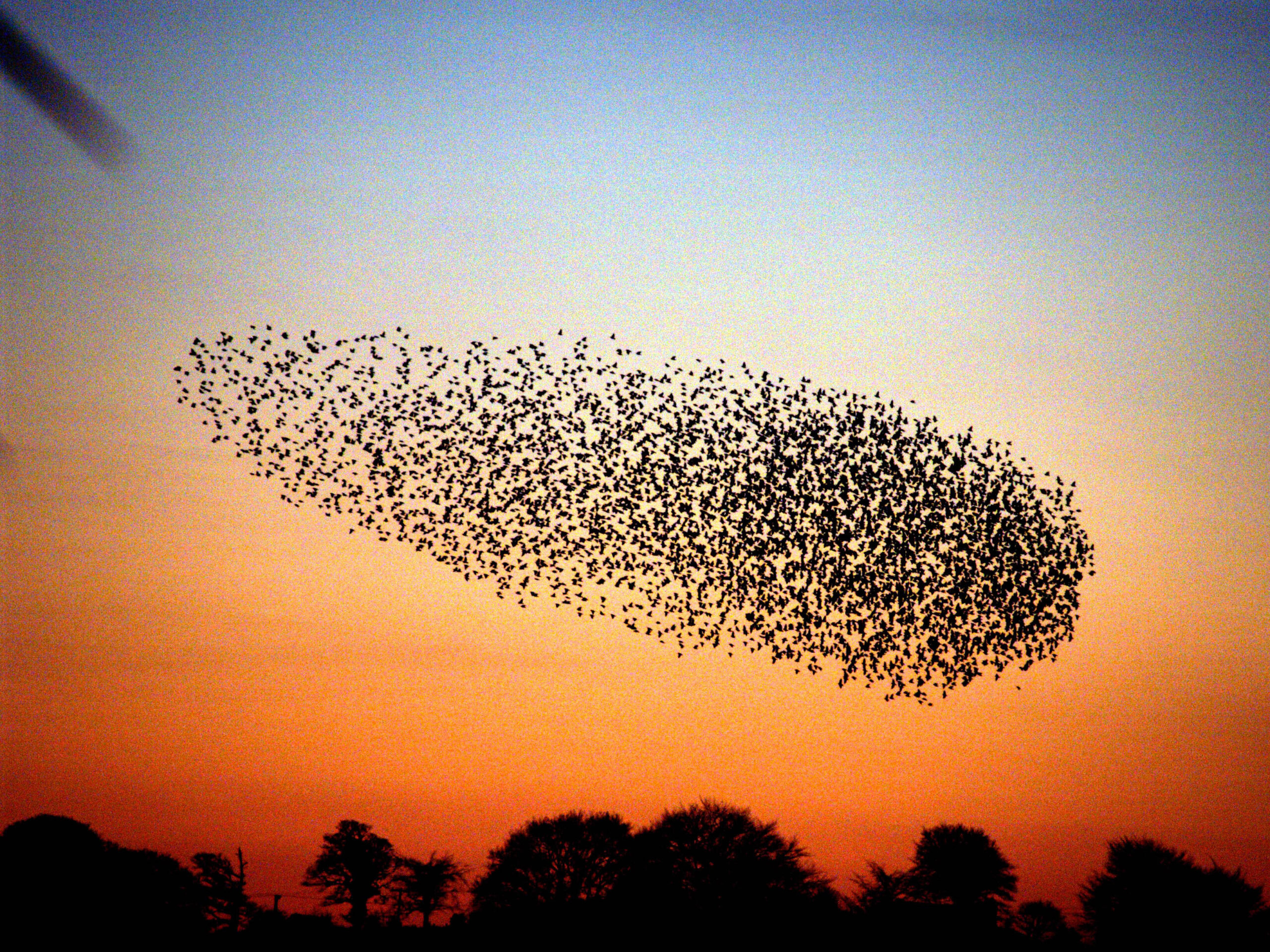Starlings
To me the most wonderful movement of all is when a vast number of creatures – fish or birds – move in unison. I recently watched a gigantic flock of starlings wheeling above the twilit Shannon here below me: one moment they stretched out in a line a hundred metres long; suddenly they clustered into a globe; then they became a giant funnel swirling through the sky like a tornado and it seemed almost frightening (it always makes me think of one of those Old Testament plagues descending upon the Egyptians); then they became almost invisible as they wheeled away to show only the edges of their wings; and then, as if obeying some incredible design, they formed an absolutely perfect teardrop shape – a zeppelin in the sky – curved at the front, and tapering gracefully back to a sharp point at the rear. The front of the teardrop was denser, like a kind of warhead, where the starlings were more concentrated.
It was as if the whole flock had suddenly acquired one single mind, become one single body of which the individual starlings were only cells. Luckily I had my camera to hand and managed to get a photograph of it [35].
This is known as a murmuation of starlings and can contain more than 100,000 individuals (some authorities say half a millon). There are some incredible videos of these murmurations on YouTube. There is an astonishing one taken at Gretna in Scotland — just google Starlings at Gretna to watch it on You Tube. It is almost terrifying to watch a shape in the sky like a giant winged dragon coming towards you, suddenly becoming a gigantic blanket in the sky that looks about to descend and smother you. Once again it makes me think of the biblical Plagues of Egypt coming to destroy the land.
I have been reading some of the comments on this particular video.
A man called Scott Masson writes from Oklahoma that he had seen something similar there: ‘It had the most profound spiritual effect on me. I can’t even explain it or put it into words. After an incredibly difficult week in my personal life, this one moment completely shifted everything. I now all of a sudden have renewed hope about life and the world in general. Witnessing natural phenomena such as this is a gift.’
Just up from my home, at Lough Derg on the river Shannon, are regularly some of the most wonderful murmurations I have ever seen. Recently two young English women, Sophie Windsor Clive and Liberty Smith, out canoeing on the lake, captured a two-minute film of one such murmuration, that has become an international wonder on the Vimeo website with three million hits at the time of writing this. To see it, check Suggestions at the end of this chapter.
How do the starlings do it? No one really knows. Some suggest it’s an instance of chaos theory. Scientist Wayne Potts believes it works like a chorus line at the Folies Bergères – one individual initiates a movement, and the others follow within milliseconds. Perhaps, because recent studies indicate that starlings have a reaction time of between 20 and 100 milliseconds.
But how could that explain a sudden perfect teardrop shape? Could any bird brain dictate such a shape in an instant, never mind conceive it? Biologist Rupert Sheldrake suggests a phenomenon which he calls morphic resonance. The theory suggests that the flock operates in some kind of field of influence – a ‘morphic field’ which, Sheldrake says, provides a ‘structured context within which the animals’ communications and responses occur’.[i]
In more recent studies Sheldrake concludes that telepathy is more pervasive than we ever guessed, and that a mind stretches far beyond the skull which we thought confined it.[ii] Perhaps like radio waves? Could this help to explain murmurations?
Italian scientists Dr Michele Ballerini and Dr Andrea Cavagna have been studying the starlings of Rome, using synchronised movie cameras to capture the movements in three dimensions, and physicist Irene Giardina suggests that starling flocks are ‘a critical system’, somewhat similar to crystals uniting at a critical temperature or avalanches forming at a critical point of tension.
But no one yet knows how this criticality is actually created or maintained. Apparently it is similar to what operates in proteins and neurons, according to some universal principle yet to be understood.
It seems that every individual starling may at a critical point be connected to some single invisible network, or even together become temporarily a single entity.
To me that sounds very much like a single mind taking over. But I’d better leave that to the scientists, who tell us the jury is still out. And anyhow, as a BBC commentator put it, we don’t always need to ask why – ‘sometimes we should just sit back and enjoy the show.’
